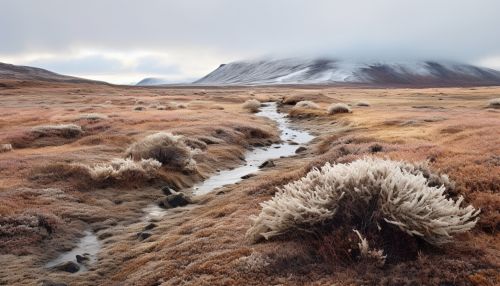The Chemistry of Permafrost Thaw and Greenhouse Gas Emissions
Introduction
Permafrost, a perennially frozen layer of soil in polar regions, has been a subject of extensive study due to its significant role in global climate change. The thawing of permafrost, triggered by rising global temperatures, releases trapped greenhouse gases such as carbon dioxide (CO2) and methane (CH4), contributing to global warming. This article delves into the chemistry involved in the thawing of permafrost and the subsequent release of greenhouse gases.


Permafrost and Its Composition
Permafrost is defined as ground (rock or soil) that remains at or below 0°C for at least two consecutive years. It is primarily found in the high latitudes of the Northern Hemisphere, in regions such as Siberia, Alaska, and Canada. Permafrost can range from a few meters to several hundred meters in thickness and is categorized into layers: the active layer, which thaws and refreezes annually, and the permanently frozen layer beneath.
Permafrost is composed of a mixture of ice, rock, and organic material. The organic material is derived from dead plants and animals that have been preserved in the cold, oxygen-poor conditions. This organic matter is a significant store of carbon, estimated to be twice the amount currently present in the atmosphere.
Chemistry of Permafrost Thaw
The thawing of permafrost is a complex process involving both physical and chemical changes. As global temperatures rise, the active layer of the permafrost begins to thaw, releasing the trapped organic matter. This organic matter is then available for decomposition by microorganisms.
The decomposition of organic matter is a chemical process that involves the breakdown of complex organic molecules into simpler compounds. In the presence of oxygen (aerobic conditions), microorganisms metabolize the organic matter to produce CO2, water, and energy. However, in the absence of oxygen (anaerobic conditions), a different group of microorganisms metabolize the organic matter, producing CH4 and energy.
Greenhouse Gas Emissions
The gases produced during the decomposition of organic matter – CO2 and CH4 – are potent greenhouse gases. While CO2 is the most prevalent greenhouse gas emitted by human activities, CH4 is far more potent, with a global warming potential 28 times greater than that of CO2 over a 100-year period.
The release of these gases from thawing permafrost represents a significant source of greenhouse gas emissions. Current estimates suggest that permafrost regions could release up to 1.5 trillion metric tons of carbon into the atmosphere by 2100, a scenario that could exacerbate global warming.
Implications and Future Research
The thawing of permafrost and the subsequent release of greenhouse gases is a significant concern in the context of global climate change. Understanding the chemistry of this process is crucial for predicting future greenhouse gas emissions and developing strategies to mitigate their impact.
Future research in this field is focused on improving our understanding of the factors that influence permafrost thaw and the associated greenhouse gas emissions. This includes studying the types of microorganisms involved in the decomposition process, the rate of thaw, and the influence of other environmental factors such as moisture and nutrient availability.
